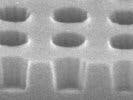To help achieve these goals, the use of photonic quasicrystal structures can both significantly enhance the luminous flux emitted by current LED technology and also place the light where it is needed.
High-brightness LEDs represent a multi-billion dollar market and strong future growth is anticipated in particular for ultra-high brightness devices. Before lighting applications can be addressed adequately, the industry still faces considerable performance-related challenges. The total and specific luminous flux currently available is still only borderline for some tasks, despite the increased efficacy achieved by modern LEDs. White light projection tasks such as automotive headlighting and projection displays are two examples of applications needing exceptionally highly efficient, as well as tailored, light output.
To help meet these demands, the effective light output of an LED can be optimized by both improving photon extraction efficiency and effectively shaping the intensity distribution for the task at hand, uniform or not. Planar photonic crystals, and in particular photonic quasicrystals, provide a cost-effective and flexible route to achieving this goal.
+++++++
To read the rest of this article, please register for a free subscription to LEDs Magazine Review.Why?
Existing subscribers:Click here to enter your reader number and download the new issue.






